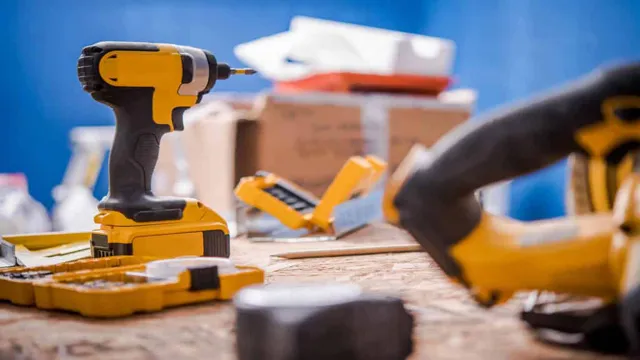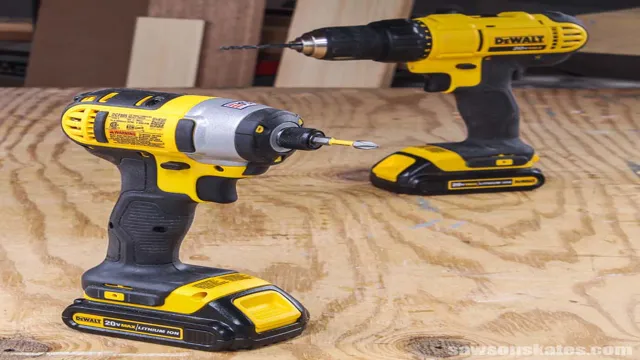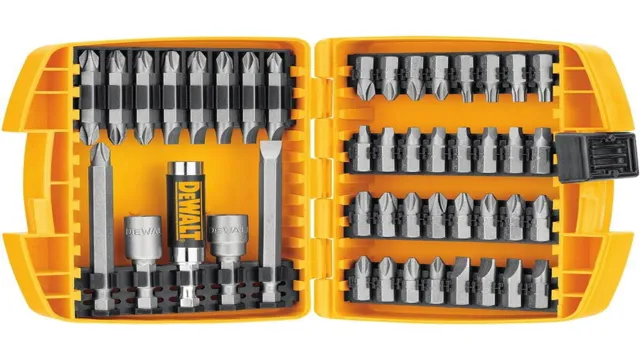Can I Use an Impact Driver as an Impact Wrench? Here’s What You Need to Know.
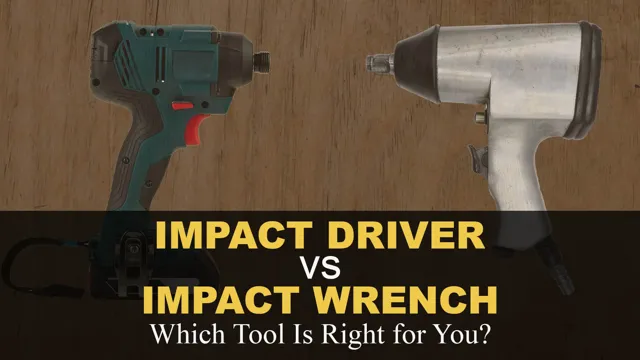
Have you ever found yourself confused about the difference between an impact driver and an impact wrench? You’re not alone. These power tools have similar names and can seem interchangeable, but they serve different purposes. An impact driver is typically used for driving screws and small fasteners, while an impact wrench is designed for heavy-duty applications like removing lug nuts on a car or truck.
Think of an impact driver as a precision tool and an impact wrench as a brute force tool. In this blog post, we’ll break down the differences between these two power tools and help you understand which one is right for your next project.
Impact Driver: What Is It?
While an impact driver and an impact wrench may look similar, they actually serve different purposes. An impact driver is designed to work with screws and uses rotational force to drive them in, while an impact wrench is designed for loosening or tightening bolts and utilizes rotational force to do so. However, there are cases where you may be able to interchange the two tools depending on the job requirements.
If you have a job with smaller bolts, an impact driver can potentially work as an impact wrench as long as the torque requirements are within the driver’s capabilities. However, for larger bolts, an impact wrench is the appropriate tool as it can generate significantly more torque than an impact driver. So, to answer the question, it depends on the size of the bolts and the torque requirements – an impact driver may be able to handle smaller bolts, but larger bolts require the use of an impact wrench.
Description and Functionality
An impact driver is a powerful tool designed for driving screws into tough materials such as wood, metal, or concrete. It works by delivering concussive blows to the screw, making it easier to drive it in or out without stripping the screw head or damaging the material. The main function of an impact driver is to provide more torque than a traditional cordless drill, making it ideal for jobs that require more power and efficiency.
An impact driver is a must-have tool for DIY enthusiasts and professionals alike, as it can save time and effort in completing various tasks such as framing, decking, and heavy-duty screw driving. Additionally, its compact size and lightweight design make it easy to use in tight spaces and overhead applications. If you’re looking for a reliable and efficient tool for your next project, consider investing in an impact driver, and you won’t be disappointed!
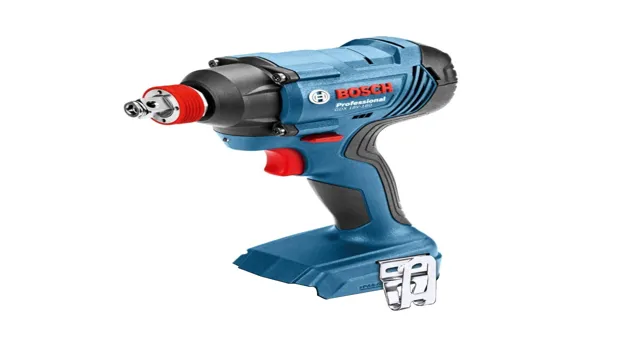
Pros and Cons of Using an Impact Driver
An impact driver is a powerful tool that can help you drive and remove screws quickly and easily. Unlike a traditional drill, an impact driver uses concussive force to provide more torque and speed, making it ideal for tougher jobs requiring more power. However, with great power comes great responsibility, and an impact driver may not be suitable for every project.
Some pros of using an impact driver include its speed, power, and ability to handle tough materials. On the other hand, some cons may include the potential for overdriving screws, causing damage to the material or tool, and the need for additional accessories like impact-rated sockets and bits. Therefore, it’s important to weigh the pros and cons before deciding if an impact driver is the right tool for the job.
Impact Wrench: What Is It?
While an impact driver and an impact wrench may seem like they perform the same function, they are actually two very different tools. An impact driver is primarily designed for driving screws and fasteners into various materials, while an impact wrench is mainly used for tightening and removing bolts, nuts, and other fasteners. So, can you use an impact driver as an impact wrench? Although they may look similar, an impact driver simply doesn’t have the same torque output or socket driving capabilities that an impact wrench does.
So, while you may be able to get some results when using an impact driver for light-duty applications, it certainly won’t be a substitute for the high-powered capabilities of an impact wrench. So, if you’re in need of a tool to handle heavy-duty fastening tasks, an impact wrench is definitely the way to go.
Description and Functionality
An impact wrench is a power tool that is commonly used in automotive and construction industries. It is designed to deliver high torque output with minimal strain on the user’s muscles. The tool operates by using a motor to generate rotational force, which is then transferred to a hammer mechanism.
This hammer mechanism delivers a series of quick, strong blows to the output shaft, allowing the user to apply high levels of torque to fasteners such as nuts and bolts. With its powerful performance, an impact wrench is an essential tool in heavy-duty applications. It’s like having a supercharged arm that can effortlessly loosen even the most stubborn bolts.
So if you’re looking to complete challenging projects with ease and efficiency, an impact wrench is undoubtedly a tool you should consider.
Pros and Cons of Using an Impact Wrench
An impact wrench is a powerful tool used to tighten or loosen nuts and bolts quickly. It is a handheld device that is used extensively in the automotive industry, construction sites, and a variety of mechanical and engineering applications. One of the biggest advantages of using an impact wrench is that it saves time and energy, making tasks that would normally take hours to complete much more comfortable and quicker.
However, there are some disadvantages to consider before using an impact wrench, including the potential risk of injury when handling the device, excessive noise levels produced, and the fact that it can strip threads or damage bolts if not used correctly. Overall, using an impact wrench can be an effective way to increase work efficiency, but it is important to weigh both the pros and cons before deciding if it is the right tool for your needs.
Can You Use an Impact Driver as an Impact Wrench?
If you’re in a pinch and need to remove some nuts or bolts, you might be wondering if you can use an impact driver as an impact wrench. While there are some similarities between the two tools, they’re not interchangeable. An impact wrench is specifically designed for heavy-duty fastening applications, with a high torque output that can handle even the toughest nuts and bolts.
On the other hand, an impact driver is better suited for driving screws and smaller fasteners, with a lower torque output that’s not strong enough for heavy-duty work. So while you might be able to use an impact driver on some nuts and bolts, it’s not recommended and could damage the tool. If you need to remove stubborn fasteners, it’s best to use the right tool for the job and invest in an impact wrench.
Key Differences to Consider
When it comes to power tools, it’s essential to understand the differences between them to ensure that you’re using them correctly and safely. One common question is whether you can use an impact driver as an impact wrench. The short answer is no.
Although they may look similar and have some overlapping functions, they have different designs and purposes. An impact driver is primarily used for drilling and driving screws, while an impact wrench is designed to provide high torque to tighten or loosen bolts and nuts. Impact drivers often have a 1/4-inch hexagonal chuck to hold hex-shaped bits, while impact wrenches typically have a square drive to accommodate socket sets.
So, while an impact driver can provide some additional assistance for smaller tasks, it’s not powerful enough to replace an impact wrench for more heavy-duty tasks. It’s always best to use the right tool for the job to ensure safety and efficiency.
When to Use an Impact Driver Instead of an Impact Wrench
Impact driver An impact driver is a versatile tool that can be used for a variety of tasks, but it is important to know when it is appropriate to use it over an impact wrench. While an impact driver is great for driving screws and bolts into various materials, it isn’t always the best option for heavier duty tasks. An impact wrench, on the other hand, is designed to handle larger bolts and nuts, making it better suited for tasks like changing tires or working on automotive repairs.
While it is possible to use an impact driver as an impact wrench, it is important to ensure that you have the right adapter and sockets to do so. Using an impact driver for tasks it isn’t designed for can cause damage to both the tool and the materials you’re working with, making it a costly mistake. In general, if you’re working with smaller screws and bolts, an impact driver is an excellent choice.
It provides precision and control, making it easier to work in tight spaces and with delicate materials. However, if you need more power or are working with larger bolts, an impact wrench is the better option. Ultimately, the decision to use an impact driver or impact wrench will depend on the task at hand.
By understanding the differences between these tools and their intended uses, you can ensure that you’re always using the right tool for the job. So next time you’re faced with a fastening task, consider whether an impact driver or impact wrench is the best choice for the job at hand.
Conclusion
In summary, while an impact driver and an impact wrench may look similar, they serve different purposes. Using an impact driver as an impact wrench is like using a hammer to tighten a screw- it might work, but there’s a higher chance of causing damage or not achieving the desired outcome. So unless you enjoy playing Russian roulette with your power tools, it’s best to stick to using each tool for its intended purpose.
“
FAQs
What is the difference between an impact driver and an impact wrench?
The main difference between an impact driver and an impact wrench is their intended use. Impact drivers are designed for driving screws and small bolts, whereas impact wrenches are designed for heavy-duty applications like loosening or tightening lug nuts on cars or trucks.
Can an impact driver be used as an impact wrench?
While an impact driver can theoretically be used as an impact wrench, it’s not recommended due to the different torque needs. Impact drivers typically have lower torque than impact wrenches, and the different bit size would also need to be taken into account.
What size bits are compatible with impact drivers and impact wrenches?
Impact drivers typically use 1/4″ hex bits, while impact wrenches typically use 1/2″ square drive bits. However, there are adapters that can convert between the two sizes.
Can I use an impact wrench to drive screws?
While it is possible to use an impact wrench to drive screws, it’s not recommended due to the high torque output which can easily strip out the screw head.
What are some common uses for an impact wrench?
Some common uses for an impact wrench include loosening or tightening lug nuts on cars or trucks, removing rusty or stubborn bolts, and working on heavy machinery.
What are some common uses for an impact driver?
Some common uses for an impact driver include driving screws, drilling small holes in wood or metal, and assembling furniture or cabinets.
Can impact wrenches be used with socket sets?
Yes, impact wrenches can be used with socket sets as long as the sockets are the correct size for the wrench and have a 1/2″ square drive.
